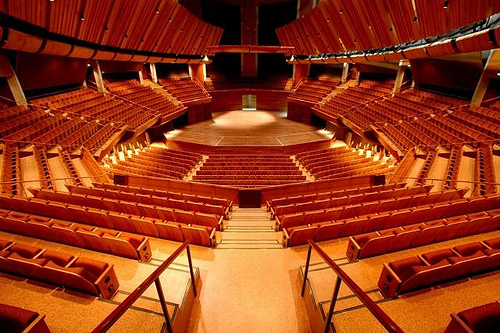Elastic Update
24 June 2015 by Marc Taddei
The Michael Fowler Centre (2209 seat capacity)
At the end of last year I wrote a blog on the economics of orchestral music, specifically the concept of Elasticity. To recap, elasticity refers to how demand for a specific good or service responds when the price changes. My view is that orchestral services are highly elastic, with significant competition from other performers, arts organizations and mass culture offerings.
For our 2015 season, Orchestra Wellington chose to confront this concept and the need to fill an enormous hall (our natural home is closed for earthquake strengthening) through a radical pricing structure for our entire subscription series.
I’m pleased to say that as a result of the programme concepts, the use of a single soloist and a pricing structure that made the orchestra accessible to all, our subscription base has grown to over 1000 subscribers for every concert. When one includes walk-up purchases, dignitaries and sponsors, the concerts are attracting well over 1600 per concert.
I also believe that as the season progresses towards its exciting conclusion and word of mouth spreads, we will be looking at halls in excess of 2000 by the end of the season.
Here are a couple of demand curve elasticity graphs. The first is based on total tickets sold for the entire 2014 season, compared with total tickets sold up to the first concert of 2015, while the second is based on the total number of subscribers in each of the seasons. Looking at these figures, please bear in mind that these figures are correct up until our first subscription concert and we have just finished our second. The numbers have changed again,to the orchestra’s great good fortune, as well as our (hopefully!) delighted audience members. While the average ticket price at the end of the initial subscription offer in 2015 was considerably lower than that of 2014, by the first subscription concert, it was trending upwards due to our individual ticket sales markedly increasing. The reason that this has happened is that the initial subscription offer has expired and we are now seeing the public purchasing tickets at the full individual ticket price closer to the concert date. As this trend continues throughout the year, the average price will continue to (slowly) rise while the total ticket sales are sure to continue to rise significantly until the end of the season.

PED = 2.907

PED = 10.851
Clearly our concerts appear to be very elastic (and I’m not talking about our nuanced and expressive approach to music making!) and it appears as if price is the determining factor in all of this. But hold on – things may not be as simple as this. Last year, the orchestra performed in three different venues, due to the temporary closure of the Wellington Town Hall and two of these venues proved not to find favor with many audience members. In response, we have put all of our subscription concerts in the Michael Fowler Centre – the most favored of the three venues. One must also look at the programme for the season, which features a very tightly conceived theme with a beloved soloist.
The orchestra has a cunning plan to clarify some of these questions. A plan so cunning, that I am not at liberty to discuss it with you at the moment, but suffice it to say that we will be able to get a clearer idea of the relative impact of price versus programme design! I think that our experience will be closely followed by many of our colleagues in the wider arts community and I do hope that by the start of next year’s season, a bright economist might be able to produce a rigorous interpretation of the data.
Finally, I would like to thank the General Manager of Orchestra Wellington, Adan Tijerina for his well-reasoned response to this challenge. His work has significantly impacted on our audience size and he has provided the orchestra with a brilliant platform from which to grow further support and enthusiasm in the community.
